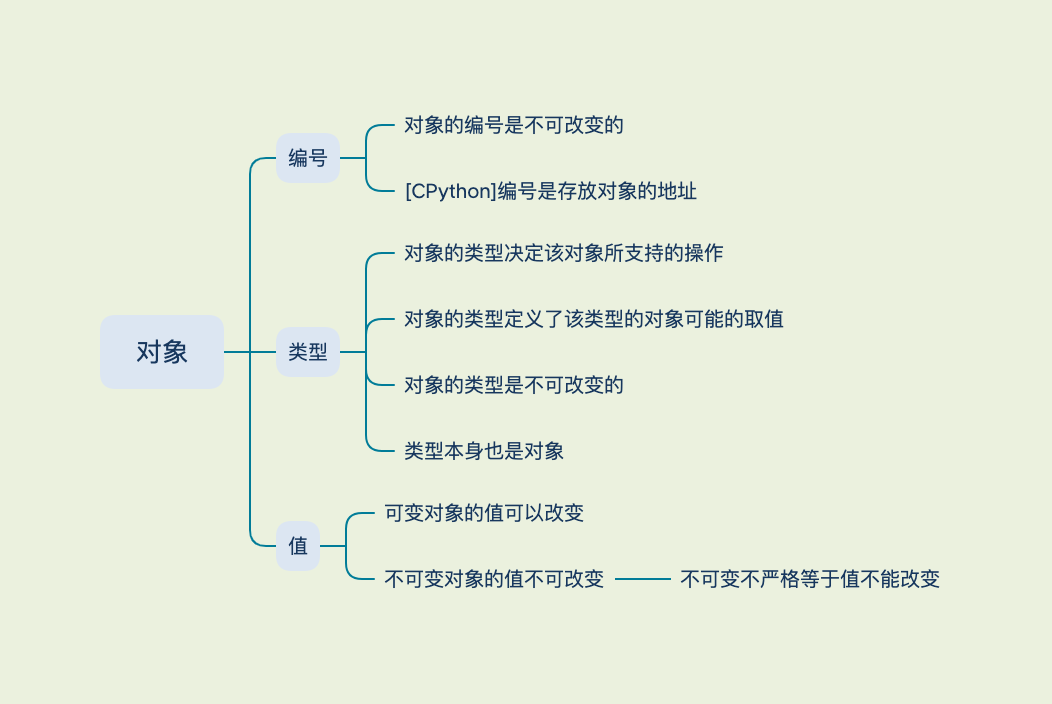面向对象(Object Oriented)是软件开发方法,一种编程范式。 –百度百科
Python 中的对象
- Python 中一切皆对象
- 对象 是对数据的抽象
- 对象 拥有编号(id)、类型(type)、值

Python 面向对象的特性
封装
访问限制
-
Python 对属性权限的控制是通过属性名来实现的,如果一个属性由双下划线开头
__,该属性就无法被外部访问。 -
但是,如果一个属性以
__xxx__的形式定义,那它又可以被外部访问了,以__xxx__定义的属性在 Python 的类中被称为特殊属性,并且通常我们不应该把普通属性用__xxx__定义。 -
以单下划线
_开头的属性_xxx虽然也可以被外部访问,但是按照约定,他们不应该被外部访问。另外该属性不能被子类继承,也不会被from module import *导入关于 Python 中下划线用法的总结可参考
https://dbader.org/blog/meaning-of-underscores-in-python
继承
定义新的 Student 类继承已定义的 Person 类
- 一定要用
super(Student, self).__init__(name, gender)去初始化父类,否则,继承自Person的Student将没有name和gender - 函数
super(Student, self)将返回当前类继承的父类,即Person,然后调用__init__()方法,注意self参数已在super()中 传入,在__init__()中将隐式传递,不需要写出(也不能写) - 初始化父类的属性后,只需要再把子类额外的属性加上
# Person 类
class Person:
def __init__(self, name, gender):
self.name = name
self.gender = gender
# 继承 Person 的 Student 类
class Student(Person):
def __init__(self, name, gender, score):
super(Student, self).__init__(name, gender)
self.score = score
多重继承
- D 同时继承自 B 和 C,也就是 D 拥有了 A、B、C 的全部功能。多重继承通过
super()调用__init__()方法时,A 虽然被继承了两次,但__init__()只调用一次。 - 多重继承的目的是从两种继承树中分别选择并继承出子类,以便组合功能使用。
graph BT
subgraph 菱形继承
B --> |继承| A
C --> |继承| A
D --> |继承| B
D --> |继承| C
end
class A:
def __init__(self, a):
print("init A...")
self.a = a
print("end A...")
class B(A):
def __init__(self, a):
print("init B...")
super(B, self).__init__(a)
print("end B...")
class C(A):
def __init__(self, a):
print("init C...")
super(C, self).__init__(a)
print("end C...")
class D(B, C):
def __init__(self, a):
print("init D...")
super(D, self).__init__(a)
print("end D...")
d = D(1)
# 调用结果
init D...
init B...
init C...
init A...
end A...
end C...
end B...
end D...
从上述调用结果不难看出:Python 中从 Object 继承来的类,会采用广度优先搜索的方式(其背后是 C3 算法)来进行继承。
方法解析顺序(Method Resolution Order,MRO)
Python 多继承场景下,需要特别注意类的继承顺序,否则会导致系统异常,如下所示:
class A:
pass
class C(A):
pass
class B(A, C):
pass
B()
# 调用结果
...
TypeError: Cannot create a consistent method resolution
order (MRO) for bases A, C
多态
同一类事物在运行过程中表现出不同的状态
多态的两个条件:
- 继承
- 重写
Python 作为一种动态语言,崇尚鸭子类型鸭子类型,参数在传入之前无法确定也不需要声明参数类型,可以像多态一样工作但无需继承,并支持实现多态性。